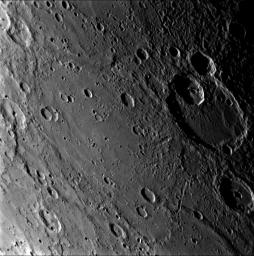
|
MESSENGER Dances by Matisse
- Click the image above for a larger view
- Full-Res JPEG (1016 x 1024) (200.1 kB)
- Full-Res TIFF (1016 x 1024) (1.0 MB)
Caption:
As the MESSENGER spacecraft approached Mercury on January 14, 2008, the Narrow Angle Camera (NAC) of the Mercury Dual Imaging System (MDIS) snapped this image of the crater Matisse. Named for the French artist Henri Matisse, Matisse crater was imaged during the Mariner 10 mission and is about 210 kilometers (130 miles) in diameter. Matisse crater is in the southern hemisphere and can be seen near the terminator of the planet (the line between the sunlit, day side and the dark, night side) in both the color (see PIA10189 ) and single-filter, black-and-white single (see PIA10179 ) images released previously that show an overview of the entire incoming side of Mercury.
On Mercury, craters are named for people, now deceased, who have made contributions to the humanities, such as artists, musicians, painters, and authors. The International Astronomical Union (IAU) oversees the official process of naming new craters and other new features discovered on bodies throughout the solar system. Scientists studying and mapping unnamed features can suggest names for consideration by the IAU. The 1213 images taken by MESSENGER during its first flyby encounter with Mercury cover a large region of Mercury's surface previously unseen by spacecraft, revealing many new craters and other features that will need to be named.
Mission Elapsed Time (MET) of image: 108821375
Background Info:
These images are from MESSENGER, a NASA Discovery mission to conduct the first orbital study of the innermost planet, Mercury. For information regarding the use of images, see the MESSENGER image use policy .
Cataloging Keywords:
| Name | Value | Additional Values |
|---|---|---|
| Target | Mercury | |
| System | ||
| Target Type | Planet | |
| Mission | MESSENGER | Mariner |
| Instrument Host | MESSENGER | Mariner 10 |
| Host Type | Orbiter | Flyby Spacecraft |
| Instrument | Mercury Dual Imaging System (MDIS) | |
| Detector | Narrow Angle Camera (NAC) | |
| Extra Keywords | Artwork, Crater, Grayscale | |
| Acquisition Date | ||
| Release Date | 2008-01-23 | |
| Date in Caption | 2008-01-14 | |
| Image Credit | NASA/Johns Hopkins University Applied Physics Laboratory/Carnegie Institution of Washington | |
| Source | photojournal.jpl.nasa.gov/catalog/PIA10190 | |
| Identifier | PIA10190 | |
